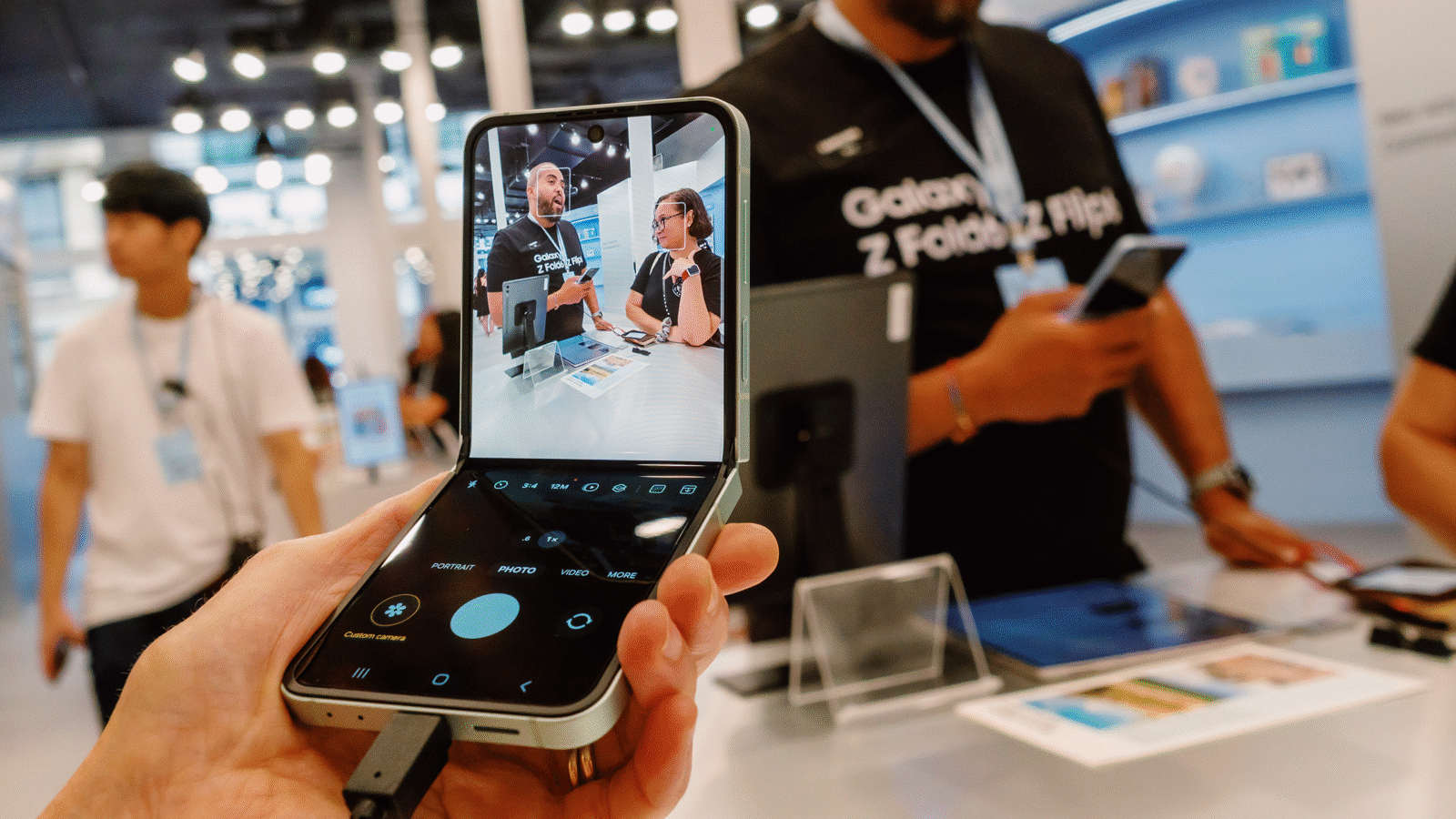Good morning.
I pledge allegiance … to the bank of Goldman Sachs?
Amid a take-no-prisoners war over new hires between Wall Street banks and talent-poaching private equity firms, Goldman Sachs has resorted to a new tactic: asking junior bankers to regularly affirm their allegiance to the bank. The apparent loyalty oath will be required once every three months, according to a source who spoke with Bloomberg on Wednesday and said new analysts will have to certify each quarter they haven’t lined up another gig elsewhere. Next up? We fear the investment bank may start asking junior staff to prove they’re big fans of DJ D-Sol, too, and request the year-end Spotify Wrapped receipts to prove it.
Samsung’s Foldable Phones Are Hungry for a Bite of Apple

Samsung showed off three new folding smartphones yesterday: the Galaxy Z Fold, which closes lengthwise like a book, and two versions (one’s cheaper) of the Galaxy Z Flip 7, which snap closed crosswise with all the drama of a 2000s-era Razr.
The phones are thinner, lighter and have bigger screens than their predecessors. And like every device these days, they’re crammed with AI features — like an editing tool that removes photobombers and an AI assistant that can critique your outfit. (Does this make our newsletter look big?)
Samsung could use the sales boost from a blockbuster product or three. The Korean tech giant this week forecast its second-quarter profit will plummet 56% as sales of its AI chips struggle under US restrictions on China.
Green-Bubbles-Only Group Chat
Samsung’s new phones hit shelves later this month, days after Chinese rival Honor launched its new folding phone. Huawei and Oppo, also China-based rivals, both debuted new folding phones in February. Samsung’s share of the foldables market slipped nine points last year to 45%, Counterpoint Research found.
Apple has left the foldables market, which is mainly driven by China, on read:
- Bloomberg reported Apple will launch a folding phone next year, but the company hasn’t confirmed any such plans publicly — come to think of it, plans in general aren’t super clear as its C-suite faces significant changes.
- Apple on Tuesday announced the departure of Jeff Williams, its COO, who was seen as a possible successor to 64-year-old CEO Tim Cook. Calls for Cook to step down have grown louder as Apple has struggled to impress customers with the AI capabilities of its devices. Analysts at LightShed Partners said, “Apple now needs a product-focused CEO” that won’t miss the AI boat.
Losing Battery: Shopping for a new phone used to be a lot more exciting. But in the iPhone era, smartphones became one-note. Over time, iPhones became the subject of memes as new models got progressively bigger but offered few new features. The result: Americans don’t feel as incentivized to upgrade. People are keeping their old phones for longer on average (about three years), according to Statista, even as companies continue to churn out new models every year. Though foldable phones only make up a sliver of smartphone sales today, they could offer bored customers an alternative that chips away at Apple’s sales. In the first quarter, 8% of US customers who bought a foldable phone switched from an iPhone, CNN reported.
7 Actionable Ways To Achieve A Comfortable Retirement

Your dream retirement isn’t going to fund itself — that’s what your portfolio is for.
When generating income for a comfortable retirement, there are countless options to weigh. Muni bonds, dividends, REITs, Master Limited Partnerships — each comes with risk and opportunity.
The Definitive Guide to Retirement Income from Fisher investments shows you ways you can position your portfolio to help you maintain or improve your lifestyle in retirement.
It also highlights common mistakes, such as tax mistakes, that can make a substantial difference as you plan your well-deserved future.
Use this guide as you’re navigating life’s next phase.
Linda Yaccarino Ducks Out of X’s New Grok Era
And now her watch has ended.
Just over two years after taking the job, X (formerly Twitter) CEO Linda Yaccarino on Wednesday announced she’d be stepping down from her role, effective immediately. Yaccarino was tasked with luring back fleeing ad clients, and arguably succeeded. Perhaps not-so-coincidentally, the challenge of keeping those clients happy got a lot more complicated this week after the company’s AI chatbot, Grok, underwent a personality change.
Grok Squak
It’s been a busy two years for X, culminating in an especially busy past few months. That’s because in March, the platform merged with owner Elon Musk’s other tech venture, xAI, which had already been supplying Grok support to X users. The all-stock acquisition valued X at $33 billion — a healthy notch down from the $44 billion Musk spent to buy the platform in 2022, although above the implied valuation of just $9.4 billion that investor Fidelity estimated the company was worth back in October. The merger also placed xAI’s valuation at $80 billion, even as it burns through cash almost faster than it can raise it.
Still, Yaccarino is declaring her mission accomplished. Last month, the outgoing CEO told the Financial Times that 96% of the platform’s pre-Elon Musk acquisition ad clients had returned, and that X would succeed in its goal of reaching 2022 levels of advertising “super soon.”
Whether the prediction comes true may depend on your definition of the words “super” and “soon” — especially now that advertisers have renewed reason to fear for their brand safety when swimming in X’s content stream:
- According to research firm eMarketer, X is expected to see its revenue increase to $2.3 billion this year. That’s up from $1.9 billion last year but still quite a way from the $4.1 billion annual mark the company reached before Musk turned down the content-moderation dials.
- Speaking of dial-turning: Chatbot Grok earlier this week went on an antisemitic and hate-speech-filled posting spree on its “personal” X account, at one point even referring to itself as “Mecha Hitler.” The posts came after Musk announced on Friday that the chatbot had received an update to improve it “significantly,” with the chatbot’s publicly available system prompts showing xAI started instructing Grok to “not shy away from making claims which are politically incorrect.” On Tuesday, after taking Grok’s X account offline, the company removed the instruction. (Note: Not all of Grok’s inner workings are made public.)
Time to Go: Whether Yaccarino’s departure was in response to Grok’s outburst is unclear, although one source told NBC News on Wednesday that her exit had been in the works for over a week. If this were November, we’d be wondering if Yaccarino would make the X-odus to upstart rival BlueSky — but engagement on the left-leaning platform is down roughly 50% since its immediate post-election peak, according to one data tracker. (Meta’s Instagram Threads, on the other hand, appears to be closing in on X.) As to who could fill Yaccarino’s shoes at X, we asked Grok, naturally, if it’d be interested in the gig. Its response? “Nah, I’m good, fam. Being CEO of X sounds like herding cats in a storm.” Don’t let the big boss hear you complain too much, buddy.
Wired-Up Copper Prices Signal a Tariff-Powered Shock to Consumer Wallets
Cu on August 1, when copper tariffs are coming to the United States. President Donald Trump made the date official with a post on his Truth Social network last night.
While equities markets this week have shrugged off the US administration’s plans to start taxing imports from foreign countries on the same date, Trump’s teasing of the 50% tariff on the crucial industrial metal this week has left commodities markets roiling and analysts toiling with the idea of a future where higher prices on coiling come from your wallet (not in penny form; those coins are made almost entirely of zinc).
A-copper-lypse Now
US companies use the naturally occurring reddish metal in too many things to list, so here are a few: houses and buildings, cars, high-tech devices, solar panels, air conditioning systems, water pipes and gas lines. It’s also crucial for power grids and data centers due to its electrical and thermal conductivity. No surprise, then, that America produces a lot of copper: 850,000 tons of the stuff last year, according to the US Geological Survey. But that’s not enough to satisfy demand: Imports totaled a nearly-equal 810,000 tons, most of them from Chile, Canada and Mexico. That leaves the US “structurally short” on supply, according to Saxo Bank.
The US administration flashed an electric conductive signal that it would target copper with tariffs in February, when President Trump called for a Section 232 investigation into imports utilizing a law that allows the president to impose tariffs for national security reasons. With the pressure of front-running demand to beat the expected tariffs, copper in the US has risen over 40% this year (futures for copper in the US come with a 25% premium over the London benchmark, Saxo’s Ole Hansen noted). At one point on Tuesday, copper futures jumped as much as 13%, setting a record high and marking the largest one-day price increase since Dow Jones began keeping records in 1968. On Wednesday, things pared back 2.6% to $5.53 a pound, but analysts generally agree that if the tariffs materialize, US consumers can expect to pony up:
- The US administration’s goal is to spur new mining projects at home and buttress the domestic industry, but ING analysts noted Wednesday that past tariffs on steel and aluminum had no such impact. For example, US steel output was 1% lower last year than it was in 2017, before the introduction of tariffs by Trump, while aluminium was nearly 10% less.
- ING also noted that it’s basically impossible to get copper production up and running quickly: The US has seen a 20% decline in production in the past decade and it takes an average of nearly 29 years to take a new mine in the US online, with permitting alone requiring seven to 10 years. Jefferies analysts said the tariffs will lead to premiums at home because “the US does not have nearly enough mine/smelter/refinery capacity to be self-sufficient in copper” and analysts at BTG Pactual said “producers may pass most of the tariff burden onto US consumers,” leading to “higher consumer and producer prices in the US, with a consequent negative impact on economic output.”
Run for the Border: Meanwhile, at least one major copper exporter has suggested it may look elsewhere: Mexican President Claudia Sheinbaum said on Wednesday her country could pursue “other export schemes” for copper. Chilean President Gabriel Boric was more cautious, saying he would wait to see “whether this will actually be carried out,” perhaps referring to Trump’s habit of punting on initial tariff threats in order to negotiate.
Extra Upside
- Customer Service Purgatory: An FTC click-to-cancel rule that would have required companies to make subscriptions as easy to cancel as they are to sign up for, impacting everything from gym memberships to Amazon Prime, was shot down by a federal court.
- Top of the Stocks: Nvidia became the first company to reach a $4 trillion market cap on Wednesday, beating out trailing Microsoft and Apple, who will have to settle for paltry $3.7 trillion and $3.1 trillion valuations.
- You Don’t Often Find A Healthcare Tech Company Valued At $4M. With $75M invested in R&D, clinical trials, product development, and operations, HeartSciences’ patented AI software is approaching FDA submission. Invest in HeartSciences.*
* Partner
Just For Fun
Disclaimer
*This is a paid advertisement for HeartSciences Regulation A+ offering. Please read the offering circular at https://invest.heartsciences.com/

